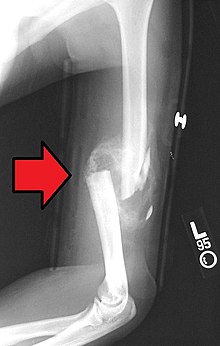Sarmiento brace
A Sarmiento brace , also known as a brace for short , is a stiff plaster of paris or plastic bandage, with the help of which fractures of the long tubular bones can be treated functionally and conservatively in traumatology . The association is named after the surgeon Augusto Sarmiento Rosillo, who first described it.
function

In contrast to the conventional immobilization in a plaster of paris or plastic bandage, the Sarmiento brace is made in such a way that the adjacent joints remain largely free to move. The fracture is immobilized here by applying pressure to the soft tissue covering that surrounds the fracture. The brace usually consists of two half-shells, which - secured by Velcro fasteners - tightly enclose the injured limb. The brace is removable and can be individually adapted to changes in the injured extremity (e.g. due to decreasing soft tissue swelling) thanks to the Velcro fasteners. According to Sarmiento, a rigid bone-to-bone contact with immobilization of the adjacent joints is more of a hindrance than desirable for the healing of the fracture. Movements of the fracture fragments against each other accelerate the sprouting of capillaries into the fracture gap and thus promote osteogenesis .
commitment
As part of the conservative treatment of humerus shaft fractures , the Sarmiento brace has been a permanent fixture since the 1980s and is considered to be the modern standard therapy for fractures in the middle shaft area. The treatment is less suitable for fractures in the proximal and distal shaft area due to the more complicated leverage that exists here. After initial complete immobilization in the Gilchrist or Desault dressing until the fragments have first made contact with connective tissue (this is usually the case after 10-14 days), the brace is applied and left for about 6-8 weeks.
The brace is used less frequently for fractures of the forearm, especially isolated ulnar shaft fractures. In the case of conservatively treated lower leg fractures - especially in childhood - a so-called “Sarmiento cast” is used: Instead of immobilization in the thigh cast, mobility in the knee joint is released to the extent that the fracture is avoided by overstretching.
Individual evidence
- ^ Augusto Sarmiento, LL Latta: Functional Fracture Bracing. 2nd edition, Verlag Springer, Berlin - Heidelberg - New York 1995, ISBN 3-540-55356-8 limited preview in the Google book search
- ↑ H.-P. Scharf, A. Rüter (Ed.): Orthopedics and trauma surgery. Elsevier Urban & Fischer, Munich - Jena 2009, ISBN 978-3-437-24400-1 , pp. 487-488. limited preview in Google Book search